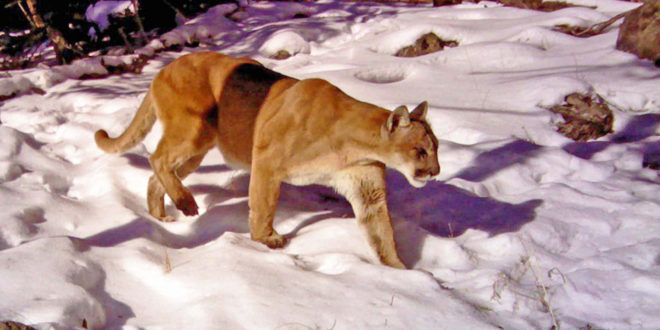With new technology and techniques, researchers are learning more and more about Yellowstone National Park’s cougar population.
According to Brett French, writing in the Billings Gazette, researchers in Yellowstone’s Cougar Project are using new techniques and measurements to fill in gaps in the existing body of Yellowstone cougar knowledge—DNA analysis of scat and hair, along with GPS collaring and photographing. The work goes far to paint a picture of Yellowstone’s most elusive predator. From the Gazette:
“Because cats aren’t seen or heard much, they’re kind of out of sight, out of mind,” said Dan Stahler, Cougar Project manager.
“We’re trying to change the dialogue and get the public to understand this is a multi-predator ecosystem,” he added. “There’s another top predator that also plays an important role here.”
The work builds on a 1998 through 2005 study by biologist Toni Ruth that documented changes in cougar populations following wolf reintroduction. Ruth is writing a book on her findings and research. The first cougar study in Yellowstone began in 1987, but there was an eight-year gap between the end of Ruth’s project and the latest study.
Lesser known
Ask someone to name Yellowstone’s top predators, and grizzly bears and wolves are more likely to be mentioned than mountain lions. Yet Stahler’s study, along with the previous work on cougars, shows that a fairly stable population seems to roam the rugged region between the Lamar Valley and Gardiner known as the Black Canyon of the Yellowstone. Elevations in the area range from 5,300 to 9,500 feet.
“That suggests that Yellowstone serves as a core area for cats,” Stahler said, and that the animals migrate from the park to find new territories in surrounding landscapes.
Cougar estimates in the study area have varied from about 15 to 42, a count that includes subadults and kittens.
It’s a study area that covers steep, rocky, forested slopes along the Yellowstone River where year-round elk populations — along with the occasional bighorn sheep, marmot, porcupine and pronghorn — provide enough sustenance to maintain a steady cougar population.
Although elk numbers prior to wolf reintroduction in 1995 hit about 19,000, they have since plummeted to what has become a new normal of about 4,800. Surprisingly, although their main prey source has been depleted, cougar numbers seem to have stayed about the same, Stahler said.
Researchers are balancing “old-school field biology” techniques (such as following cougar tracks in snow, weather pending) with new advances in DNA analysis. Indeed, Stahler told the Gazette “A single hair with a follicle is enough” for comprehensive analysis, identifying individuals and linking related cats. According to Stahler, research in 2014 and 2015 has identified 20 unique cougars in the region.
Also new, according to Stahler, are GPS collars outfitted with accelerometers—so-called “cougar fitbits”—that let researchers track activity level and hunting success alongside seasonal location and habitat. From the Gazette:
Although cougars have claws that give them an advantage over wolves for grasping and taking down their prey — and they are as muscle-laden as body builders — they are a short-range hunter, using quick bursts of speed to capture their prey.
“We do see scenes where there’s been quite a battle,” Stahler said. “They’ve fallen off cliffs attacking bighorn sheep.”
Female cougars will make a kill on average about once a week, compared to once every 11 to 13 days for males, Stahler said.
A pack of wolves, on the other hand, will run long distances before making a kill about every two to three days, but there are more mouths to feed in a pack. Wolves and bears will also chase off cougars to take over their kills, evidence of what Stahler calls Yellowstone’s “multi-carnivore system.”
Camera spies
Camera traps are the final bit of technological wizardry the Cougar Project is using with help from National Geographic photographers. The remotely activated cameras are being set up to document the elusive cat’s behavior, since they are so rarely seen in the wild.
So far the cameras have captured photos and video of family groups interacting, scent marking and have shown which cats are in a certain area. The most vivid example of this was when a male cougar showed up on camera with what appeared to be battle scars only days after another male cougar was killed in a territorial fight.
Overall, Stahler says, the new research fleshes out Yellowstone’s cougar knowledge and points to Yellowstone National Park as “a pretty healthy landscape for cats.”
 Yellowstone Insider Your Complete Guide to America's First National Park
Yellowstone Insider Your Complete Guide to America's First National Park





